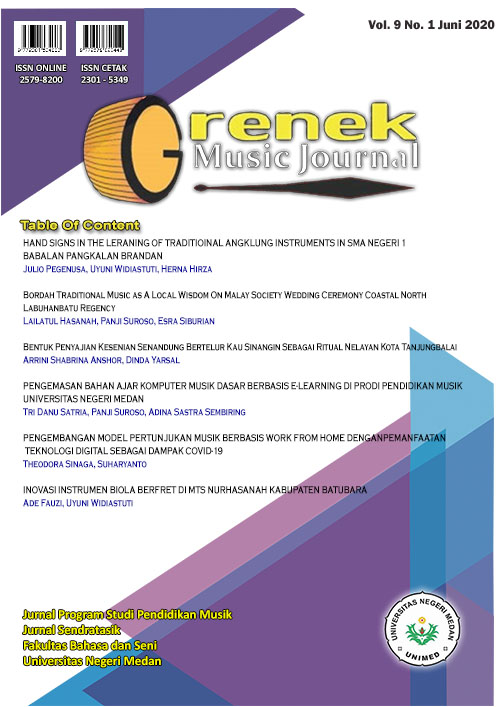INOVASI INSTRUMEN BIOLA BERFRET DI MTS NURHASANAH KABUPATEN BATUBARA
Main Article Content
Abstract
The purpose of this study 1) To determine the learning process of the violin using the innovation of the fret violin instrument at MTs Nurhasanah Batubara Regency, 2) To determine the process of making the violin instrument innovation. The theories used are innovation theory, learning theory, violin theory, and fret (tone barrier). Data collection techniques through observation, interviews, and documentation. The results of this study indicate 1) The learning process of the violin includes an explanation of the parts of the violin and their functions followed by reading music notation with tabulated numbers and teaching material from the Suzuki method manual. 2) The production of the stringed violin instrument consists of several stages, including: (1) the manufacturing process, (2) the manufacturing steps, (3) the materials used, and (4) the advantages and disadvantages of the stringed violin instrument. The manufacturing process is quite simple, just adding a fret that is planted on the fingerboard and then measured by a cromatic tuner measuring instrument.
Article Details
Section
Grenek Music Journal

This work is licensed under a Creative Commons Attribution-ShareAlike 4.0 International License.
Authors published with the Grenek: Jurnal Seni Musik agree to the following terms:
- Authors retain copyright and grant the journal the right of first publication with the work simultaneously licensed under a Creative Commons Attribution License (CC BY-SA 4.0) that allows others to share the work with an acknowledgment of the work's authorship and initial publication in this journal.
- Authors are able to enter into separate, additional contractual arrangements for the non-exclusive distribution of the journal's published version of the work (e.g., post it to an institutional repository or publish it in a book), with an acknowledgment of its initial publication in this journal.
- Authors are permitted and encouraged to post their work online (e.g., in institutional repositories or on their website) prior to and during the submission process, as it can lead to productive exchanges, as well as earlier and greater citation of published work. (See The Effect of Open Access)
